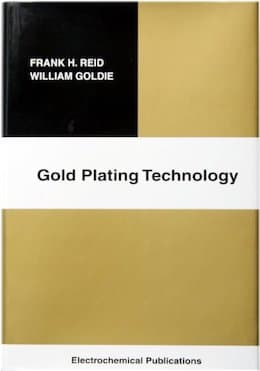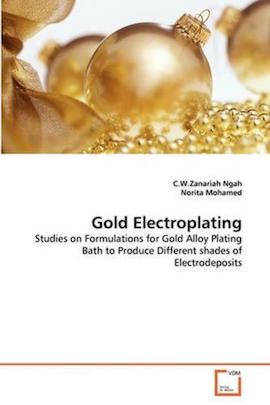
-----
Testing porosity of gold plating
Q. Copper Sulphate Test on Gold Plated Part?
Hi, my name is Yogesh Sachdeva. One of my customers is asking for 2% Copper Sulphate Solution Test on room temperature on Brass component with Nickel and Gold Plating.
Is this test relevant after Gold Plating? And also when I did this it failed.
- DELHI, INDIA
March 1, 2024
A. Hi Yogesh.
Please read on for more appropriate tests, but if copper sulfate reacted with the finish I believe your gold plating is porous and you would have failed any and all porosity tests. How thick are the nickel and gold plating layers?
Luck & Regards,

Ted Mooney, P.E. RET
Striving to live Aloha
finishing.com - Pine Beach, New Jersey
Ted is available for instant help
or longer-term assistance.
⇩ Related postings, oldest first ⇩
Q. Could you suggest some techniques to check for gold porosity over nickel?
We plate electroless Ni and then Au over copper circuitry to produce semiconductor packages. I suspect Au porosity is causing us adhesion problems during subsequent Au wirebonding operations.
Regards
Yezdi Dordi- Fremont, California
1996
A. Hi Yezdi. The nitric acid porosity test sounds like what you're looking for. Start with ASTM B735 or ISO 14647. Good luck!

Ted Mooney, P.E.
Striving to live Aloha
finishing.com - Pine Beach, New Jersey
Ted is available for instant help
or longer-term assistance.
A. There is surely a more easy test; the so-called Dimethylglyoxim test.
You have to make a solution of:
980 ml Ethanol,
7 g dimethylglyoxim
20 ml De-ionised water
1 g Ammonium chloride
Dissolve the components in this sequence. Stir until all components are dissolved
Use a voltage stabilized rectifier at 1.5 V
Make the test sample the anode; use SS-cathodes at 5 - 10 cm distance
Place the sample 1.5 minutes in this solution and rinse it with clear ethanol.
Pores will be visible as very intense red discolored area's.
Use the normal care while handling all chemicals and equipment
Success and let me hear if you were satisfied with this; as far as I know this is an official DIN-ISO -test method.
Bye,
Harry

Harry van der Zanden
consultant - Tilburg, Netherlands
A. Thanks Harry. I don't know the spec number that covers that test, but maybe ISO 10308, "Metallic coatings - Review of porosity tests" would be a good starting point.
Luck & Regards,

Ted Mooney, P.E. RET
Striving to live Aloha
finishing.com - Pine Beach, New Jersey
Ted is available for instant help
or longer-term assistance.
![]() Harry/Ted,
Harry/Ted,
Thanks for the suggestions.
So far I have tried exposing the substrate to fuming Nitric acid (just to the fumes for 2 hrs). The problem with this technique is that it still attacks the underlying substrate material (glass reinforced epoxy resin) and lifts up the narrow traces (2 mils), making further inspection difficult.
I will be trying the dimethylglymoxil test next week once I can come up with a fixture to make the anodic connection to the circuitry.
thanks again for the suggestions.
Yezdi Dordi- Fremont, California
Q. In which specification is this test mentioned? Thank you for your support.
Jean Ph. Mundorff-Kirchdorf, Switzerland
2004
Multiple threads merged: please forgive chronology errors and repetition 🙂
by Reid & Goldie
-- hard to find & expensive; if you see a copy cheap, act fast!

on eBay or Amazon
or AbeBooks
(affil link)
Q. We are gold plating on the springs of Music Wire for one of our customers lately he's been complaining of corrosion on the gold plating .We plate nickel before plating gold and every thing seem good in testing.Any suggestions.
M. KhawarIslamabad, Pakistan
1999
A. Nitric acid porosity test maybe?

Ted Mooney, P.E.
Striving to live Aloha
finishing.com - Pine Beach, New Jersey
Ted is available for instant help
or longer-term assistance.
Q. IN RESPONSE TO MY QUESTION YOU HAVE WRITTEN NITRIC ACID POROSITY TEST. WOULD You PLEASE EXPLAIN HOW THE TEST IS DONE AND WHY SHOULD WE DO IT. THANKS AGAIN.
M. Khawar [returning]Islamabad, Pakistan
A. The gold needs to be thick enough to be non-porous. One way this is tested is by exposing the parts to nitric acid fumes. Gold is resistant to nitric acid so if the gold is pore-free the fumes will have no effect; if the fumes do reach the nickel, nickel nitrate crystals will grow at the pores. See ASTM B735 or ISO 14647 for further info on this test.

Ted Mooney, P.E.
Striving to live Aloha
finishing.com - Pine Beach, New Jersey
Ted is available for instant help
or longer-term assistance.
A. The cleaning and activation of the music wire has to be pretty stringent as the delayed reaction [i.e., corrosion at a later date], are causing you problems. Do not be fooled as it may not be the gold that is bad but rather the nickel to the substrate. If that's bad, then so is the gold.
I used to use nitric acid, rather than the fumes. I would plate, then subject the parts to a 50% v/v nitric acid at room temp for up to 15 minutes. Then would rinse, dry, then tape test and look under magnification. If they passed that test, especially the tape, then they should all be good. I used a percentage of parts in the lot plated against the total of parts in the lot. Ours were small parts so I could take 1 part for each 50 thousand parts (50 parts) and do the test.
If one failed, then I figured one in a thousand would fail. I got it down to zero defect as I had zero in my test results. That came from realizing the cleaning and number of turns on the EN bath was critical. Oh, and the gold adhesion to the nickel ... and the gold purity.
Todd Huehn- Coon Rapids, Minnesota
Multiple threads merged: please forgive chronology errors and repetition 🙂
by C W Zanariah Ngah

on eBay or Amazon
or AbeBooks
(affil link)
Gold plating on stainless steel to pass nitric acid test
Q. I have a stainless steel tube (#304) with a OD of .021 and an ID of .015. I would like to gold plate the inside and outside of this tube with a 10 to 20 mil gold layer without a base nickel layer. The nickel used in the past will not hold up to an 40 second submersion in nitric acid that I need to pass. Any suggestions?
Lenny Davis- Kansas City, Kansas
2001
A. Have you tried using an acid gold strike?
Neil BellAlbuquerque, New Mexico
A. Is your gold suffering from porosity? Try a mild steel panel and test with a ferricyanide / sodium chloride solution for porosity. This could by why the nitric is eating the nickel.

Martin Trigg-Hogarth
surface treatment shop - Stroud, Glos, England
A. Have you tried using an electroless nickel process with a high phosphorous content. These processes can withstand nitric acid better than nickel on its own.
Sharon Banner- England
A. As recommended before, a high Phosphorous coating is a good resolution, The amount of gold you require is significant -- if I am reading correctly, shouldn't the gold be enough? Anyway there is more than one solution, duplex coatings, etc.
Richard Webb- Toccoa, Georgia
Q. We are trying to accomplish a similar requirement, plating the exterior of a .043 OD 304 stainless steel tube. It will be used as a short term implanted medical device. Have you found a solution? Nickel is not desirable due to it's poor compatibility with the body.
Thomas Youd- SLC, Utah
2003
Multiple threads merged: please forgive chronology errors and repetition 🙂
Gold Plating looks good but blackens with age
Q. Our Center conductors are gold plated for electrical resistance purposes. When parts return from the plating process, they are clean and look free of plating salts or contaminants. However, a few months later, there is a black growth on these parts. Sometimes, the black penetrates the gold finish and renders the part useless. This usually happens to assembled product where any type of heavy agitation in a cleaning process may damage the assembly. I would like to know what causes this black growth and how I can prevent it from happening
Tony TubaroElectronics - Hartland, Michigan
2004
A. Because of the cost of gold there is enormous and continuous pressure to keep reducing the specified thickness. If you look at gold plating specs from 40 years ago you would find that gold plating thickness was typically 10x what it is today. The chemistry has improved greatly but today's thicknesses are often marginal at best because pragmatism dictates that we just keep pushing the envelope.
Maybe a nitric acid porosity test could demonstrate that the gold is too thin, maybe not. Yes, there are other possible explanations for the black growth, but try doubling the gold thickness on some sample parts before investing months of study on esoterica :-)

Ted Mooney, P.E.
Striving to live Aloha
finishing.com - Pine Beach, New Jersey
Ted is available for instant help
or longer-term assistance.
A. What is under the gold? Silver and copper will migrate right through the gold and show tarnish on top. Give us more information.

Robert H Probert
Robert H Probert Technical Services
Garner, North Carolina

Multiple threads merged: please forgive chronology errors and repetition 🙂
Can nitric acid vapor test (IPC TM-650) detect nickel or only copper?
Q. For industrial reel-to-reel plating, most of the companies apply porosity test: Nitric acid vapor - gold on copper, to evaluate surface condition.
It's become a standard practice. Does it purely just check for exposed copper? No way to detect nickel exposure? Any indication of color change?
plating shop employee - Singapore
August 10, 2011
Multiple threads merged: please forgive chronology errors and repetition 🙂
Q. I am looking for this paper; it's not on the net, some library hard copy?
C.A. Holden & R Luik, "Critical nitric acid vapor test parameters affecting the apparent porosity of thin and selectively plated gold coating", Plating and surface Finishing, pp 110-117, March 1982.
- Goa, India
January 9, 2022
A. Hi Anil. ASTM B735 "Standard Test Method for Porosity in Gold Coatings on Metal Substrates by Nitric Acid Vapor" isn't exactly the paper you are looking for, but it covers that technology.
"Gold Plating in the Electronics Industry" by Alain Blair, link.springer.com/content/pdf/10.1007/BF03216562.pdf, is a summary of the session in which that paper was presented; so you could look for the CD-ROM from Sur/Fin 1981 as another source for the paper as well.
A few libraries around the world, often personal ones, would have this. You might inquire of the Indian Association for Surface Finishing if anyone in your country is maintaining such a library.
"Finishing Publications Ltd & Metal Finishing Information Services" abstracted the article to their CD-ROM and presumably have it, but they obviously must charge for their work so I don't know under what terms they might offer it to you.
Luck & Regards,

Ted Mooney, P.E. RET
Striving to live Aloha
finishing.com - Pine Beach, New Jersey
Ted is available for instant help
or longer-term assistance.
Q, A, or Comment on THIS thread -or- Start a NEW Thread